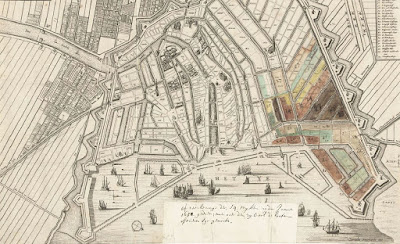The Arrival
Jan Franz Van Husum arrived in Amsterdam sometime between October of 1634 and May of 1639. These two dates separate the Grote Mandrenke, the Great Man Drowning flood and the departure the ship Den Harinck for America with Jan and Volkje aboard.
During that time Jan and Franz lived on Tuinstraat.
It was the Dutch Golden Age, an era of political, economic, and cultural greatness when the little nation facing the North Sea ranked among the most powerful in the world, sending ships to explore and settle the New World and bring back silks from exotic Japan.
Tuinstraat, Amsterdam, Google Earth, 2021
Tuinstraat, Jordaan District
Tuinstraat, in Amsterdam's Jordaan district, lies between Lijnbaansgracht and Prinsengracht, running roughly northeast, 500 meters long. Nearby was the new Dutch Reformed Westerkirche (1620-1631) situated between the Prinsengracht and Keizersgracht. Today, Tuinstraat is noted for its proximity to the Anne Frank House on Prinsengracht.
Now considered central Amsterdam, then, in the 17th century, the Jordaan District was new, reclaimed by windmills and canals from the soggy marshlands, a place for immigrants searching for low rents. Rembrandt Van Rijn (1606-1609), moved to a house on Rozengracht when he could no longer afford to live in the city center. Bloemgracht where Joan Blaeu (1596 –1673) and his father had their bookshop is a few streets south. And not far away were the great merchants’ new and opulent homes on the Herengracht Canal.
By the mid-1600s when Jan Franz Van Husum moved to Tuinstraat along with Volkje Van Nordstrand, Amsterdam was lit by a series of lanterns on every bridge and in front of every twelfth house. The Night Watchman, famously painted by Rembrandt, patrolled the streets and canals with his lantern, sword and rattle, with which to sound the alarm. Amsterdam had by now some 400 book shops and people were clamoring for books on travel, like those by Jacob Cats, which added a touch of morality.
In 1688, almost 50 years after Jan and Volkje departed for America, William of Orange and his wife Mary, sister of England’s King James, would embark on a ship headed for England and a Glorious Revolution.





No comments:
Post a Comment